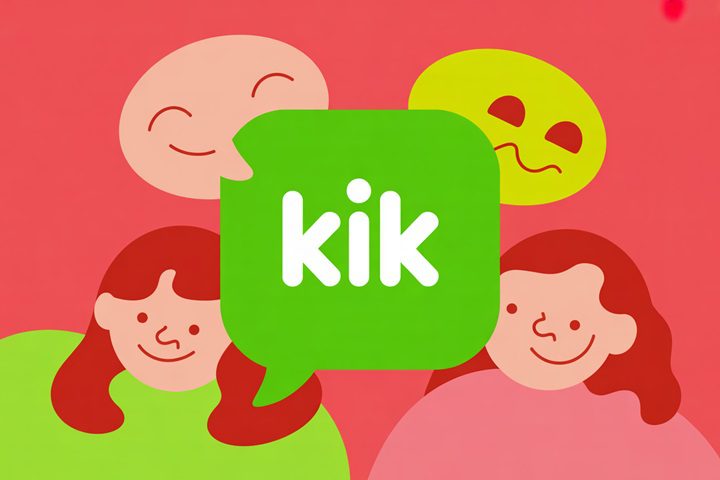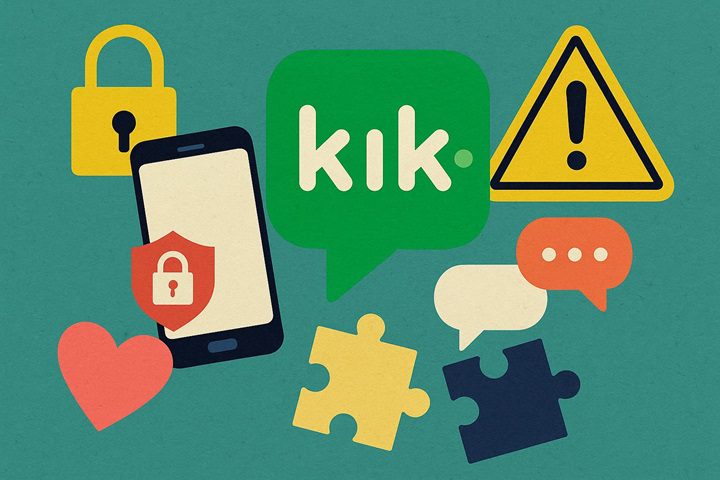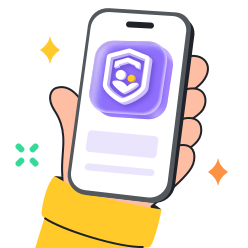As parents, the thought of our kids associating with Kik friends online can be a daunting prospect, especially with the increasing popularity of Kik Messenger among teenagers. With millions of global users, Kik has emerged as a go-to platform for teenagers to socialize, share interests, and forge new connections. But is Kik safe for teens to connect or even make new friends?
This guide is intended to give parents clear insights into the app. We’ll help to understand how teens use Kik, potential dangers for younger users, and practical ways to keep children safe.
What is Kik Messenger?
Kik Messenger is a free instant messaging and chat app. It is popular with teens for connecting with random strangers online and expanding social circles through private and group chats. It enables users to send text messages, multimedia exchanges including photos, videos, and GIFs, and even make live video calls.



Kik is also known for its simple registration. Instead of requiring personal info like phone number, like other chat apps, it only requires an email address and a username. This makes it more anonymous than other messaging apps.
With Kik, users can:
- Have one-on-one chats or join group chats with up to 49 other users.
- Share photos, videos, and other media fast and easily.
- Meet new friends with features such as public groups, chat rooms, and the “meet new people” button.Interact through chatbots, mini-games and promoted chat with brands, music, or entertainment accounts.
Kik Messenger is available both on iOS and Android, and is therefore accessible on major mobile platforms. The app’s features are designed to help users make friends, encourage communication, and join communities based on interests.
When kids explore online, parents lead the way with the right method and tool.
The appeal of the Kik app for young users
Teens are attracted to Kik Messenger for a variety of intriguing reasons that meet their developmental needs of privacy, social connection, and ease of use. This appeal, however, is closely intertwined with the potential for risky behavior, especially when seeking out friends.
Some of its core appeals for teens include.
- Anonymity: Random stranger chats separate users from their real-world social circles. This also feels like a shield from parental oversight. However, anonymity has raised concerns about Kik, as it can also encourage malicious behavior.
- Simplicity: Kik is a very simple, no-frills messaging app that enables quick and direct communication. Teens may be overwhelmed by the complications and “performance” of other, more public social media platforms.
- Group chats and shared interests: Kik makes it incredibly easy to join or create public group chats based on specific interests or fandoms. This is an efficient way for young people around the world to connect with new Kik friends who share their passions.
How users connect and find Kik friends
One of the defining elements of Kik Messenger is the array of different methods the platform provides for people to find and connect with one another.
Understanding how teenagers find and add friends on Kik is important, especially for parents looking to understand the risks of the platform and set proper boundaries.



Kik’s built-in methods for connection
Kik offers a number of native features that make it easier for users to connect with each other.
1. Kik username search
The simplest way to add Kik friends is to look up specific usernames directly on the app. Simply type the username into Kik’s search tool and send a contact request. This technique is usually relatively safer than random connection features, as there’s usually some kind of existing relationship involved.
2. Kik codes
Kik Codes work the same way as QR Codes. They are images you can scan that immediately connect with users. Each Kik account has a unique code that others can scan with their phone’s camera through the app. Teens may post these codes on other social media platforms, making it easy for followers to connect with them on Kik.
3. Contact sync
Kik also has a contact sync feature. It scans a user’s phone contacts and identifies which of them also use Kik. This approach matches users with people that they already know in real life, making it one of the safer built-in options. However, it accesses contact lists, which can raise privacy concerns.
4. Public groups
Kik’s public group feature lets users find and join chat rooms based on common interests, location, age, and more. These groups may include anywhere from a few to hundreds of participants, creating spaces where teenagers interact with strangers.
Risky third-party “Kik friends finder” tools
Beyond Kik’s native features, there is an entire ecosystem of external websites and applications designed to help users find strangers and connect on Kik. These external services often take the form of.
1. Public username directories
Websites such as Kikfriender, KikFinder, and the like are searchable databases. Users voluntarily post their Kik user names along with other personal information. These directories usually group people by their ages, genders, locations and interests. So users can easily identify the person they’re looking for.
2. Random chat and matching apps
Applications such as Frenzy, Friended, and others pair users at random and facilitate connections via Kik. Often, these apps gamify the process of finding friends, making it exciting and harmless for teenagers.
3. Social media hashtags and forums
Platforms such as Instagram, Twitter, and TikTok have communities where users can post Kik usernames. They use hashtags such as #kikme, #kikfriends, or #kikusernames.These decentralized techniques make it almost impossible for both parents and platform moderators to monitor use.
Is making Kik friends safe for children?
The platform claims it’s for users 18+ and technically forbids younger kids from signing up in the Kik Community Guidelines. However, this age requirement is mostly on paper, rather than in practice.
Kik’s age-verification approach is appallingly minimal, making the platform easily accessible to younger children. This minimal age verification and easy connectivity with strangers create an environment laden with dangers, particularly threatening young minds.
Some of these risks include:
- Being exposed to inappropriate content. Through chats, public groups and shared links, children can easily be exposed to explicit imagery, pornography, and other bad things.
- Over-sharing of personal information. The informal nature of chat can lead kids to accidentally share important details with their Kik friends, compromising their privacy and safety.
- Cyberbullying and harassment. The anonymity of the platform can encourage users to bully or otherwise harass one another in messages.
- Predatory behaviour and catfishing. Malicious actors often make up fake profiles to befriend minors, establish false trust, and groom them to be exploited. The figure about predator behaviour from the statistics underscores the realistic potential for predatory contact in apps that allow anonymous or pseudo-anonymous connections (like user name/code only).
These dangers are greater for underage users, who usually lack the critical judgment and emotional maturity to see the red flags or move away from the manipulative situations.
Due to inadequate official controls, parental intervention is a very important safety measure in achieving a safer online environment.
Empowering parents and children: essential online safety tips
Since connecting with Kik friends can mean exposing children to both positive social experience and potential danger, parents and kids need to have a joint strategy for staying safe.



Set the golden rules of online interaction
- The stranger rule is still golden: Ask your child to never meet an online only Kik friend or user in real life. If anyone wants to have a meeting, tell your child to inform you or a trusted adult straight away.
- Keeping personal information private: Educate your child never to share identifying information with a Kik friend or anybody online, such as a phone number, address, school name, etc.
- Think before sharing. Teach your child that they have no control over what happens to a photo or message once it leaves their device. They should never send things that they wouldn’t want the world to see.
Educate and develop critical thinking
You’ll also need to teach your child the skills to recognize risks and choose to avoid them.
- Deconstruct catfishing. Tell them that not everyone online is what he or she claims to be. Teach them that they have to be skeptical about strangers who look too perfect.
- Recognize scams and suspect links. Caution them to never click on unexpected links or download files from suspicious sources. These are common vectors of malware, phishing scams, and inappropriate content.
- Make the most of in-app safety features. Teach your child about how to adjust the built-in privacy settings. For instance, set the “New Chats” feature to mute the notifications or keep messages from new people separate and blurred.
Parental control tools for enhanced safety
Since Kik does not offer robust parental controls, a holistic third-party parental control app can provide the necessary technical oversight. One such app is FlashGet Kids. It provides parents with important visibility into their child’s device use and potential interactions with their Kik friends.
Some important features of FlashGet Kids that help improve the safety include.
- Screen mirroring. This enables the parent to see their child’s device screen in real-time. Useful for seeing who a child is chatting with on Kik and what content is being exchanged.
- Usage reports. Provides an intelligent summary of your child’s daily and weekly device activity. It informs you if they are spending too much time accessing Kik or other potentially risky app functions.
- Keywords detection. You can get notifications about different events. Customized keywords list to alert you if any sensitive keywords are used in messages.
Staying informed about digital trends
The online world is constantly changing. Commit to staying informed about new apps, slang, and/or digital trends as they are born.
Use this information to help you keep the topic of your discussion with your child current and relevant. When you come to them with knowledge, they will more likely see you as an informed partner in their digital life. And not just a restrictive figure.
Final thoughts
Making kik friends can be a positive experience for teens. But only if the safety is kept at the center of each and every interaction. Kik’s anonymity and open features make it easy to socialize. Tough families need to be on the lookout for potential dangers such as inappropriate behavior and insecure chats.
With very clear boundaries and the correct digital tools, such as FlashGet Kids, parents can help children navigate through Kik confidently. And encourage your children to make meaningful online friendships whilst practicing good, consistent, safe online behaviour.

